Hi Clint. I have one of those blue roll up tables with aluminum legs. I have been using it for over 30 years. It is large enough to cook on and much taller than the table above.
-
Happy Wright Brothers Day (1903)! 🐱🦅🛩️
You are using an out of date browser. It may not display this or other websites correctly.
You should upgrade or use an alternative browser.
You should upgrade or use an alternative browser.
General Trip Gear
- Thread starter Clint
- Start date
Ah yes. I remember you posting somewhere else a picture of the table I believe. Thank youHi Clint. I have one of those blue roll up tables with aluminum legs. I have been using it for over 30 years.
It's funny... scrolling quickly through this thread, I recognized a canoe, stove/frying pan, and pack, and stopped... yup. it was Robin's... just funny how you know people by their gear combos sometimes.
I pack a bit heavier with my daughter, a lot heavier with my wife, very light when alone.
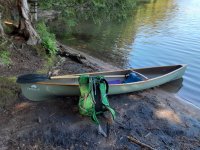
Tarp camp looks like this:
Klymit pad, tyvek under, golite gust pack, simmerlite stove
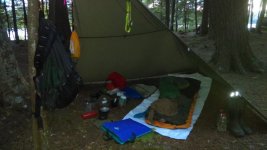
Hammock camp looks like this:
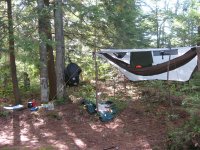
This is the 'heavy load' with my daughter... you can see my yellow drypack, the wannegan, and space for her pack (still on shore) in the middle. I have a small daypack for sundries and my PFD in back, and her kneeling pad and life jacket are up front.
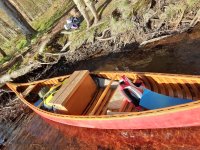
I pack a bit heavier with my daughter, a lot heavier with my wife, very light when alone.
- My shelter is either a hammock system or tarp/air mattress, with either a poncho or piece of tyvek for the ground.
- Sleeping bag is a light down sleeping bag in summer or a heavy down quilt in spring/fall
- Rain gear is either the poncho (not ideal for canoeing) or REI rain jacket and some sort of cheap pants. I have purchased some Frogg Toggs for experimental use this year.
- Stove is a SuperCat alcohol, with a couple 12oz soda bottles for fuel, as needed. Sometimes bring a Simmerlite or Pocket Rocket, especially if moving frequently or cooler weather.
- I generally make oatmeal for breakfast, have a cold lunch, and rehydrate something for dinner. I use a 5-cup "Mors Pot" over a fire most of the time, over alcohol stove if really rainy. I rehydrate said meal in a KoolAid jar in a foam cozy.
- Food, paper towels in a ziplock (3 per day), and spices reside in a waterproof stuff sack of various sizes depending on length of trip. This enables sinking it in the water to keep the bacon cool, if I bring it. Bacon is generally skewered on a stick and broiled over the fire, so i don't need a frying pan. My solo utensil is a lexan tablespoon. I also have a lexan mug.
- Water system varies with the trip, but can be as simple as Aqua Mira (3oz) or Polar Pure (5oz), Sawyer mini (don't remember the weight) or Platypus gravity filter system (8oz). I typically use 1 water bottle with the filter, or 2 with chemicals, and carry a bladder for use in camp as well.
- Clothing is usually minimal; worn would be socks and boots, pants, synthetic underwear, synthetic T, a ball cap, and a nylon overshirt. I carry a Swiss Army knife, compass, chapstick, lighter, and micro-light in my pockets.
- Typical extra clothing would be a pair of socks, a fleece shirt, a knit hat, and sometimes a luxury cotton t-shirt to sleep in. Underclothing gets rinsed out daily in the afternoon, pants and shirt every 3 days or so, as good weather permits.
- Miscellaneous 'tools' include a headlamp, first aid kit (mostly meds, in a Mentos container), Repair kit (prescription bottle with 3-4' of gorilla tape), sometimes a Leatherman Squirt (in tackle box), TP, 25' of thin cord, a spare couple Bic minis tucked in various places, a map, and usually a folding saw and hatchet. My favorites are a Silky GomBoy and a Norlund hatchet.

Tarp camp looks like this:
Klymit pad, tyvek under, golite gust pack, simmerlite stove

Hammock camp looks like this:

This is the 'heavy load' with my daughter... you can see my yellow drypack, the wannegan, and space for her pack (still on shore) in the middle. I have a small daypack for sundries and my PFD in back, and her kneeling pad and life jacket are up front.

The gear I bring depends on the trip and that includes the canoe. Considerations include the season, weather forecast, the type of water paddled, the geographical area, and the duration of the trip. Tarps, tents, sleeping gear, cookware, storage and tools are all variable.
Where I most often trip these days bears are not a realistic concern but rodents certainly are, so all cookware, food, trash, and toiletries must go into a rodent-proof container of some type. I have used blue barrels of 30, 60, and 80 liter size but more recently I have come to prefer taking a pair of 5 gallon pails with Gamma Lids, one for cookware items and one for food. That way I don't have to take all the food out to get to the stove at the bottom.
I have a lightweight, highly packable single-wall tent but it has been a disappointment for river tripping in humid conditions. Too much condensation and once the interior gets wet it is very difficult to dry. So I have come to prefer free-standing tent designs with a separate fly even though they are a bit heavier and less compact.
I have a bunch of different stoves. On a three-day, three night downriver trip last week I took a small twig stove (Solo Stove) but also a small alcohol burner (Trangia type) so as to not have too bother collecting wet sticks in the rain. The Solo Stove works but is rather slow so my other option is a Jetboil Stove and isobutane cannister. If I take a saw these days it is a Silky Saw. I usually take a lightweight down bag or quilt as opposed to a heavier and less compact synthetic bag.
Sometimes I take a ultralight tarp and a couple of aluminum poles depending on weather anticipated. A couple of items that I have not taken in the past but do now are a lightweight chair and small aluminum folding table. Miscellaneous items include a Luci lantern, at least one headlamp, a sheath knife, a multi-tool, Gorilla Tape, fire-starting materials, and a compass.
Where I most often trip these days bears are not a realistic concern but rodents certainly are, so all cookware, food, trash, and toiletries must go into a rodent-proof container of some type. I have used blue barrels of 30, 60, and 80 liter size but more recently I have come to prefer taking a pair of 5 gallon pails with Gamma Lids, one for cookware items and one for food. That way I don't have to take all the food out to get to the stove at the bottom.
I have a lightweight, highly packable single-wall tent but it has been a disappointment for river tripping in humid conditions. Too much condensation and once the interior gets wet it is very difficult to dry. So I have come to prefer free-standing tent designs with a separate fly even though they are a bit heavier and less compact.
I have a bunch of different stoves. On a three-day, three night downriver trip last week I took a small twig stove (Solo Stove) but also a small alcohol burner (Trangia type) so as to not have too bother collecting wet sticks in the rain. The Solo Stove works but is rather slow so my other option is a Jetboil Stove and isobutane cannister. If I take a saw these days it is a Silky Saw. I usually take a lightweight down bag or quilt as opposed to a heavier and less compact synthetic bag.
Sometimes I take a ultralight tarp and a couple of aluminum poles depending on weather anticipated. A couple of items that I have not taken in the past but do now are a lightweight chair and small aluminum folding table. Miscellaneous items include a Luci lantern, at least one headlamp, a sheath knife, a multi-tool, Gorilla Tape, fire-starting materials, and a compass.
- Joined
- Jul 6, 2021
- Messages
- 643
- Reaction score
- 564
“The gear I bring depends on the trip and that includes the canoe. Considerations include the season, weather forecast, the type of water paddled, the geographical area, and the duration of the trip. Tarps, tents, sleeping gear, cookware, storage and tools are all variable”
Same as Pete. It’s never the same river, or lake, twice – season, anticipated weather, level, length of trip, intentions, companions or not.
The companions only matter in peculiar ways, but then most of them are peculiar in their own ways.
I bring, if not the same gear, all of the gear I need to be self-sufficient, tent, tarp, stove, cookware, and etc that could be “common gear”. Family trips are different; I know and trust what we have packed as common gear; I packed it and we split it up.
On group trips I’ll share what’s mine (except the tent), but I will not depend on sharing other folks gear. On longer trips where coordinating the sharing of some common gear - tarp, poles, stake and lines, or permit required equipment like toilet, firepan, spare PFD - is beneficial I’ll happily bring it all, and carry it in my canoe.
I will have a beer if you’re offering, but otherwise you haven’t got what I need.
Certain exceptions can be made to that rule.
If someone else wants to bring a 2-burner stove, cast iron or their mega tarp, great, the more fed and sheltered better. I think that is a common routine for trippers who occasionally have companions.
I do bring a little more on group trips. Bigger 1st aid kit, bigger tarp than I might need solo, some extra rope and line, an assortment of shareable beverages and snacks (always Berger Cookies and a large jar of cashews). I don’t often have a campfire when solo, so maybe the Trench grill, or the pie irons and late night pizza fixings.
And, from now on, the boy’s axe I refinished and hung.
https://www.canoetripping.net/threads/new-axe-project.24092/#post-24142
I always have a saw, and doubt I’ll ever bring an axe when solo, but I will next group trip.
A couple years ago, despite being among a cohort that include some skilled and practiced wood processors, we had a selection of saws (I didn’t even get mine out), but no one brought an axe. We did have more tarps than a travelling circus, but I guess everyone thought someone else was bringing an axe.
Once sawed the log sections needed splitting, and us with no axe. One of the guys sheepishly returned from his tent holding something like this, but even more miniscule, with a stubby near-palm sized handle.
https://www.amazon.com/LEXIVON-Ligh...ocphy=9007844&hvtargid=pla-947398755531&psc=1
It took some effort (I watched) to tap split using a DIYed log mallet with that (“Careful, watch my hand!”) mini-wedge. It worked, but involved many times an axe effort. And many times the risk.
Next trip with those guys I bet there will be a half dozen axes. Maybe a splitting maul.
Denouement: I had brought that Boy’s axe, and left it in the truck, thinking, “Eh, I know this pyromaniac bunch, no worries”. I’d bet there were several axes back in our vehicles.
Same as Pete. It’s never the same river, or lake, twice – season, anticipated weather, level, length of trip, intentions, companions or not.
The companions only matter in peculiar ways, but then most of them are peculiar in their own ways.
I bring, if not the same gear, all of the gear I need to be self-sufficient, tent, tarp, stove, cookware, and etc that could be “common gear”. Family trips are different; I know and trust what we have packed as common gear; I packed it and we split it up.
On group trips I’ll share what’s mine (except the tent), but I will not depend on sharing other folks gear. On longer trips where coordinating the sharing of some common gear - tarp, poles, stake and lines, or permit required equipment like toilet, firepan, spare PFD - is beneficial I’ll happily bring it all, and carry it in my canoe.
I will have a beer if you’re offering, but otherwise you haven’t got what I need.
Certain exceptions can be made to that rule.
If someone else wants to bring a 2-burner stove, cast iron or their mega tarp, great, the more fed and sheltered better. I think that is a common routine for trippers who occasionally have companions.
I do bring a little more on group trips. Bigger 1st aid kit, bigger tarp than I might need solo, some extra rope and line, an assortment of shareable beverages and snacks (always Berger Cookies and a large jar of cashews). I don’t often have a campfire when solo, so maybe the Trench grill, or the pie irons and late night pizza fixings.
And, from now on, the boy’s axe I refinished and hung.
https://www.canoetripping.net/threads/new-axe-project.24092/#post-24142
I always have a saw, and doubt I’ll ever bring an axe when solo, but I will next group trip.
A couple years ago, despite being among a cohort that include some skilled and practiced wood processors, we had a selection of saws (I didn’t even get mine out), but no one brought an axe. We did have more tarps than a travelling circus, but I guess everyone thought someone else was bringing an axe.
Once sawed the log sections needed splitting, and us with no axe. One of the guys sheepishly returned from his tent holding something like this, but even more miniscule, with a stubby near-palm sized handle.
https://www.amazon.com/LEXIVON-Ligh...ocphy=9007844&hvtargid=pla-947398755531&psc=1
It took some effort (I watched) to tap split using a DIYed log mallet with that (“Careful, watch my hand!”) mini-wedge. It worked, but involved many times an axe effort. And many times the risk.
Next trip with those guys I bet there will be a half dozen axes. Maybe a splitting maul.
Denouement: I had brought that Boy’s axe, and left it in the truck, thinking, “Eh, I know this pyromaniac bunch, no worries”. I’d bet there were several axes back in our vehicles.
- Joined
- Nov 22, 2021
- Messages
- 371
- Reaction score
- 272
I'm jumping in here kind of late. Haven't read all the posts so hope this question hasn't already been answered.
Like you, I use screw top, Gamma seal buckets. I was wondering how other people secure them in the boat?
I've always just run a strap though the wire handle, but that's really not very secure, in a capsize.
Like you, I use screw top, Gamma seal buckets. I was wondering how other people secure them in the boat?
I've always just run a strap though the wire handle, but that's really not very secure, in a capsize.
I can put two 5 gallon polyethylene pails with Gamma Lids in this Granite Gear traditional #3.5 pack.I'm jumping in here kind of late. Haven't read all the posts so hope this question hasn't already been answered.
Like you, I use screw top, Gamma seal buckets. I was wondering how other people secure them in the boat?
I've always just run a strap though the wire handle, but that's really not very secure, in a capsize.
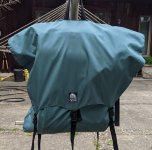
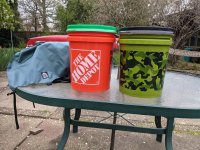
The variety of environs and the humanoids wandering there seems endless. Also whatever headspace they're bringing with them. So too the gear selection.
For these reasons I haven't spent much time on this thread till now. It is a good thoughtful thread.
A few years ago I was gifted an MSR pump style water purifier/filter. Gosh I love it. Far better than the old Katadyn unit I still hang onto. Last weekend a young fellow enthused about his Platypus Gravity Gear unit. I tried it and fell in love with it's small engineering details leading to big results. A big improvement over my old Katadyn Gravity Bag. I am not product bashing, just saying that it's helpful to try things out in the field. It was funny listening to the two young guys complaining about the "wasted effort" of pumping vs gravity. I cast a glance over at their overabundance of gorp, beer, and premade meals and thought "Ah well, what they want and what they need is an age old riddle wrapped in a mystery inside an avocado on toast. Even I can't fully fathom which gear is best but I'm danged sure glad they brought the beer.
For these reasons I haven't spent much time on this thread till now. It is a good thoughtful thread.
A few years ago I was gifted an MSR pump style water purifier/filter. Gosh I love it. Far better than the old Katadyn unit I still hang onto. Last weekend a young fellow enthused about his Platypus Gravity Gear unit. I tried it and fell in love with it's small engineering details leading to big results. A big improvement over my old Katadyn Gravity Bag. I am not product bashing, just saying that it's helpful to try things out in the field. It was funny listening to the two young guys complaining about the "wasted effort" of pumping vs gravity. I cast a glance over at their overabundance of gorp, beer, and premade meals and thought "Ah well, what they want and what they need is an age old riddle wrapped in a mystery inside an avocado on toast. Even I can't fully fathom which gear is best but I'm danged sure glad they brought the beer.
I'm of the school, not to tie my gear, into the canoe.I'm jumping in here kind of late. Haven't read all the posts so hope this question hasn't already been answered.
Like you, I use screw top, Gamma seal buckets. I was wondering how other people secure them in the boat?
I've always just run a strap though the wire handle, but that's really not very secure, in a capsize.
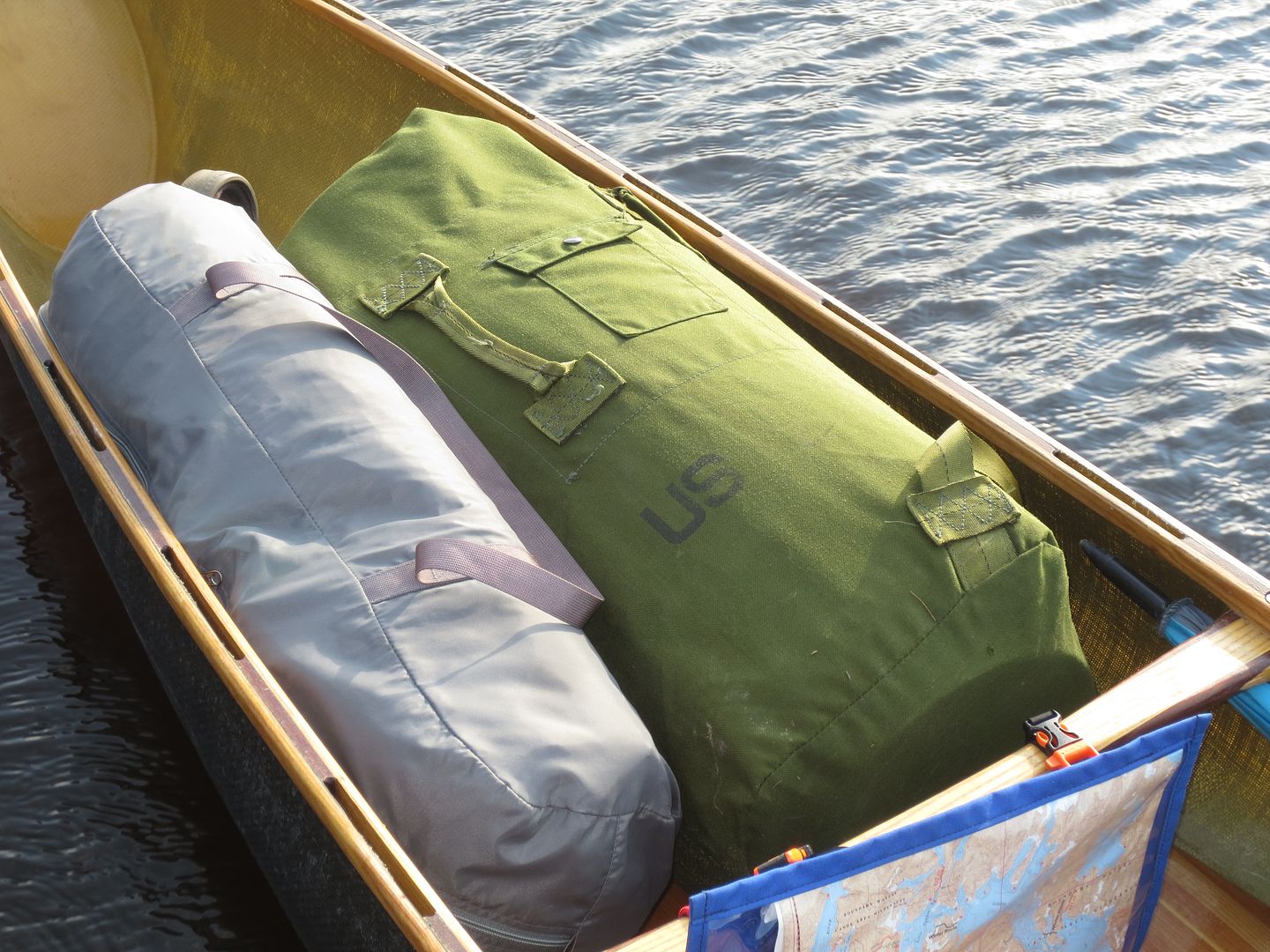
If I tip, everything will float, except maybe the tent, I could attach to my cook kit, that will float for sure.
If things are attached to the canoe, it might be a struggle to get the canoe emptied, and righted ?
Jim
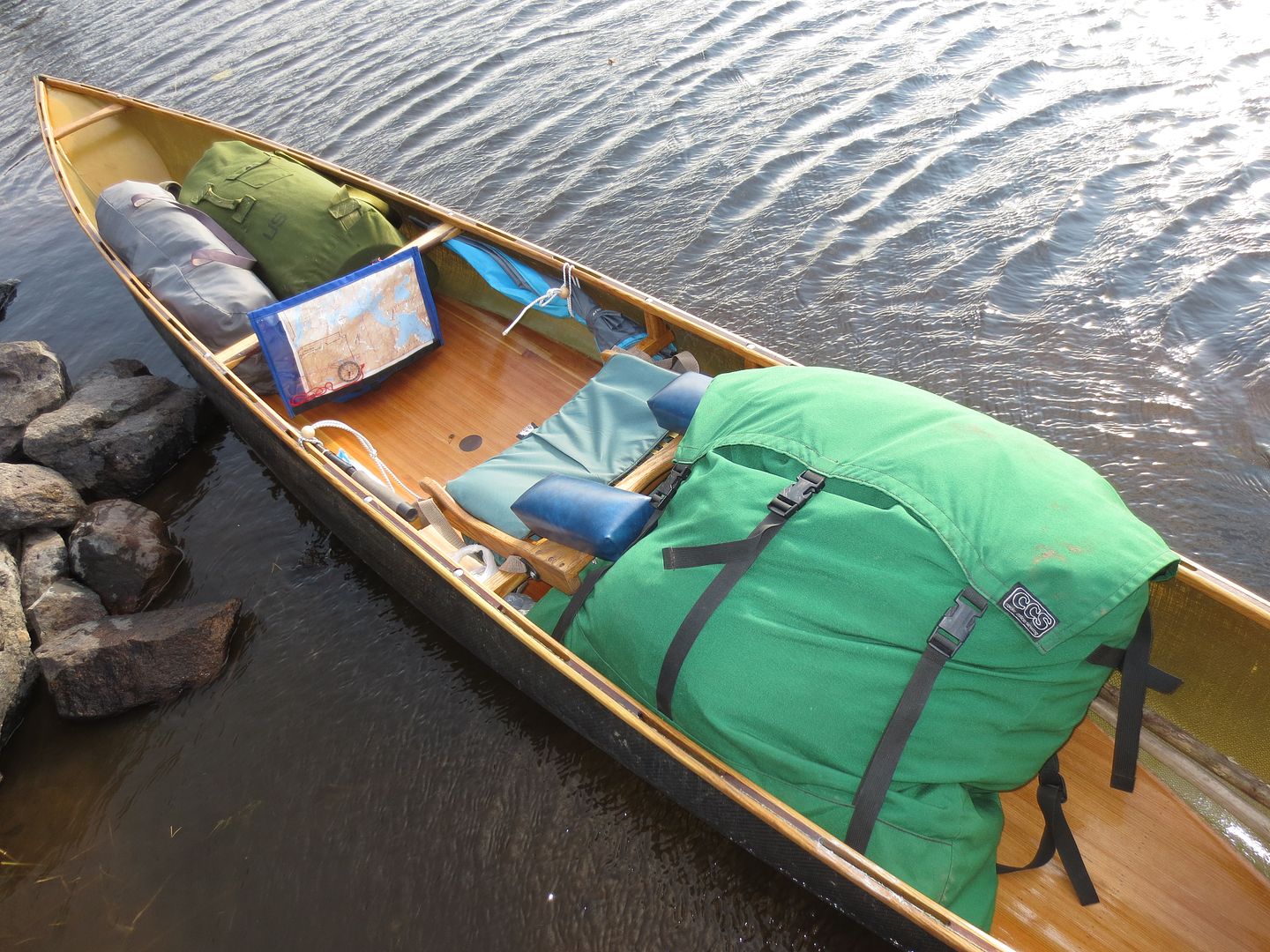
I'm of the school, not to tie my gear, into the canoe.

If I tip, everything will float, except maybe the tent, I could attach to my cook kit, that will float for sure.
If things are attached to the canoe, it might be a struggle to get the canoe emptied, and righted ?
You might want to take into account the kind of water you are paddling and whether you are with other canoes.
On really big, windy lakes or on long, fast moving rivers, any gear not tied in is going to float/blow away very quickly and will get a long, long way away from you while you are busy swimming and then righting/emptying your canoe. You may never catch up to or find your gear in that situation if you haven't tied in and don't have other canoes to help corral it.
On a small, calm lake, or a river with long flat pools and relatively short drops, your gear isn't going to go very far in the event of a capsize. So you can probably find and retrieve your gear after rescuing yourself. So not tying in makes sense for the reasons you identify -- ease of emptying/righting the canoe.
But even on a pool and drop river, there are no guarantees. After one capsize when our gear was not tied in, we quickly found all our gear in the next pool -- except for the tent. I don't know if the tent sank or just got hung up on something in the rapids, but it wasn't in the pool with the rest of the gear. It was two days from the end of the trip and we were dang lucky in that the weather was great and the bugs were non-existent so my paddling partner and I built and slept under a tarp with no issues. I was also exceedingly fortunate that some nice guy in Maine found my tent a week later and turned it in to the North Maine Woods checkpoint when he saw a wall poster they put up inside the checkpoint (after I called them to report my lost tent). It was a one-in-a-million chance since my name and number were not on the tent itself (or any of my gear) -- an oversight I have since rectified.
Al
- Joined
- Nov 22, 2021
- Messages
- 371
- Reaction score
- 272
If you dump on a river, you have a serious problem, if things aren't tied in securely. If the canoe flips and nothing moves, I've done my job.I'm of the school, not to tie my gear, into the canoe.

If I tip, everything will float, except maybe the tent, I could attach to my cook kit, that will float for sure.
If things are attached to the canoe, it might be a struggle to get the canoe emptied, and righted ?
Jim
Even on a lake, I would want things attached to the canoe so I don't have to swim around trying to gather all my stuff and drag it to shore.
Just my thoughts on it.
- Joined
- Nov 22, 2021
- Messages
- 371
- Reaction score
- 272
REI sale starts tomorrow. 20% off coupon. Might have to buy another bag.I can put two 5 gallon polyethylene pails with Gamma Lids in this Granite Gear traditional #3.5 pack.
View attachment 130839
View attachment 130841
As far as tying stuff in, I do as Bill mason suggests. On flat water tie your packs tight to the bottom of the boat so they will give you some floatation in case you swamp. In WW, tie the packs together with one rope and secure the end of the rope to the boat.
On flat water I don't typically tie my packs in, but I might on big open water. On WW I always tie my stuff as above and on my one fully loaded capsize, I was able to throw the packs out, empty the boat and reload. I was back on the water in minutes and only lost my bailer.
On flat water I don't typically tie my packs in, but I might on big open water. On WW I always tie my stuff as above and on my one fully loaded capsize, I was able to throw the packs out, empty the boat and reload. I was back on the water in minutes and only lost my bailer.
On the lakes we paddle we too have decided that tying in gear is not an option. Too many portages with sketchy shorelines. The thought of getting to shore and having to release ropes etc. all the while trying to hold on to a canoe that's bucking up and down on the waves makes me shudder. The one time I had problems on a trip was when I strained my back trying to unload gear from my canoe at a portage so I try to keep everything clean and simple to make loading and emptying as painless as possible.
We don't use the hip belts on a Granite Gear packs anymore as we found they would often catch on gunwales and thwarts, and who needs them anyway when your pack weighs less than 25lbs?
We don't use the hip belts on a Granite Gear packs anymore as we found they would often catch on gunwales and thwarts, and who needs them anyway when your pack weighs less than 25lbs?
Bill Mason did at one time recommend securing packs to the canoe with a tether rope when paddling whitewater and described doing so in Path of the Paddle and in one of his videos. But he later changed his mind on that. In Song of the Paddle he writes:As far as tying stuff in, I do as Bill mason suggests. On flat water tie your packs tight to the bottom of the boat so they will give you some floatation in case you swamp. In WW, tie the packs together with one rope and secure the end of the rope to the boat.
On flat water I don't typically tie my packs in, but I might on big open water. On WW I always tie my stuff as above and on my one fully loaded capsize, I was able to throw the packs out, empty the boat and reload. I was back on the water in minutes and only lost my bailer.
"In Path of the Paddle I suggested securing all packs on a tether so they could be easily removed for a canoe-over-canoe rescue. ... I have since changed my mind because of what I have learned in hot dog canoeing. ... Packs are always lighter than water. So if they are tied in securely, they will buoy up a swamped canoe and you can maintain some degree of flotation and mobility. ... If you swamp or upset a loaded canoe with the secured packs in waves on a lake, you can right the canoe, climb back in, and paddle it. This can save your life in cold water conditions because you are able to get out of the water immediately."
If I was paddling a long stretch of flat water in the company of other experienced paddlers in other boats, I would probably not tie in my gear since there would be the option of a canoe-over-canoe rescue which can be done very quickly to completely empty a capsized boat that is unladen.
On moving water my practice has always been to secure all gear, and whenever possible have nothing extend above the gunwales. A canoe in current that is trailing gear that is loosely attached by a tether is much more likely to hang up on strainers or mid current rocks in such a location that it is difficult or impossible to get to safely.
Last edited:
Thanks pblanc, I never caught that in Song Of The Paddle and I'm not sure I agree. I see his point, but I'd rather deal with an empty boat then one with the 150 lbs of gear I would have on a tandem trip. Maybe with more experience I would see the light.Bill Mason did at one time recommend securing packs to the canoe with a tether rope when paddling whitewater and described doing so in Path of the Paddle and in one of his videos. But he later changed his mind on that. In Song of the Paddle he writes:
"In Path of the Paddle I suggested securing all packs on a tether so they could be easily removed for a canoe-over-canoe rescue. ... I have since changed my mind because of what I have learned in hot dog canoeing. ... Packs are always lighter than water. So if they are tied in securely, they will buoy up a swamped canoe and you can maintain some degree of flotation and mobility. ... If you swamp or upset a loaded canoe with the secured packs in waves on a lake, you can right the canoe, climb back in, and paddle it. This can save your life in cold water conditions because you are able to get out of the water immediately."
If I was paddling a long stretch of flat water in the company of other experienced paddlers in other boats, I would probably not tie in my gear since there would be the option of a canoe-over-canoe rescue which can be done very quickly to completely empty a capsized boat that is unladen.
On moving water my practice has always been to secure all gear, and whenever possible have nothing extend above the gunwales. A canoe in current that is trailing gear that is loosely attached by a tether is much more likely to hang up on strainers or mid current rocks in such a location that it is difficult or impossible to get to safely.
In a rescue scenario you have to consider the weight of the water that will be occupying your swamped canoe if your gear is not in it. Usually that water is going to weigh a lot more than your gear does. If your 150 lbs of gear displaces only 18 gallons of water that would otherwise be in the canoe, it is a wash. If it displaces more than that, you come out ahead. So if you are attempting to swim, bulldoze, or pull your canoe to the riverbank, it might well be easier to do so with gear secured in it. The weight of the gear really only becomes significant when attempting to lift the boat out of the water.
Obviously, a boat-over-boat rescue is easier with an empty boat than one with 150 lbs of gear lashed in. For rescues on the river, a tandem canoe can often be drained and righted even with 150 lbs of gear in it so long as you can get it to a shallow spot where you have decent footing. Leave the canoe in the water inverted. If you boat and gear weigh a combined 200 lbs or so, and you and your tandem partner can briefly dead lift 100 lbs each, or a little more, the two of you should be able to lift the inverted boat a few inches above water level and flip it upright without removing the gear.
Obviously, a boat-over-boat rescue is easier with an empty boat than one with 150 lbs of gear lashed in. For rescues on the river, a tandem canoe can often be drained and righted even with 150 lbs of gear in it so long as you can get it to a shallow spot where you have decent footing. Leave the canoe in the water inverted. If you boat and gear weigh a combined 200 lbs or so, and you and your tandem partner can briefly dead lift 100 lbs each, or a little more, the two of you should be able to lift the inverted boat a few inches above water level and flip it upright without removing the gear.
Last edited:
I figure it will be easier to empty the water out w/o the weight of the gear. Also with 150 lbs of gear I don't think I'll ever get my load beneath the height of the gunnels.
My sweetie and I added these 12 oz. Thermos jars to our kitchen kit a few years ago. Not a lightweight solution, but it works for us.
We love oatmeal in the morning and before a trip, we prepack individual servings with a variety of dried fruit, nuts and seeds to each pack. I simply pour one serving in each of the Thermos jars, fill with boiling water, stir and the screw the lid back in. Stays warm for a few hours so we can eat it whenever convenient. Either at the site or after we leave. Cleaning out the Thermos right away is not necessary because the lid seals without a scent.
We have thought about taking it one step further and preparing our dehydrated meals in a Thermos but haven’t gone that route yet.
(they are pretty expensive to buy new but can often be found at thrift shops for very little)

We love oatmeal in the morning and before a trip, we prepack individual servings with a variety of dried fruit, nuts and seeds to each pack. I simply pour one serving in each of the Thermos jars, fill with boiling water, stir and the screw the lid back in. Stays warm for a few hours so we can eat it whenever convenient. Either at the site or after we leave. Cleaning out the Thermos right away is not necessary because the lid seals without a scent.
We have thought about taking it one step further and preparing our dehydrated meals in a Thermos but haven’t gone that route yet.
(they are pretty expensive to buy new but can often be found at thrift shops for very little)

- Joined
- Nov 22, 2021
- Messages
- 371
- Reaction score
- 272
Will all due respect to Bill Mason, standard practice for paddling white water is to make sure your gear is secured so well that it stays in place in a capsize. On some western rivers it's required by the agency in charge. Even ones without white water. They don't want gear floating down their river. On loaded trips, dry bags replace float bags. They displace water. That only works if the bags stay in place.As far as tying stuff in, I do as Bill mason suggests. On flat water tie your packs tight to the bottom of the boat so they will give you some floatation in case you swamp. In WW, tie the packs together with one rope and secure the end of the rope to the boat.
On flat water I don't typically tie my packs in, but I might on big open water. On WW I always tie my stuff as above and on my one fully loaded capsize, I was able to throw the packs out, empty the boat and reload. I was back on the water in minutes and only lost my bailer.
Obviously, on a canoe trip with frequent portages, spending a lot of time tying your gear in would be impractical, but I'd, at the very least, run one of the packs straps over a thwart or yoke and make sure there aren't loose items, like sponges and maps.
Similar threads
- Replies
- 51
- Views
- 6K
- Replies
- 64
- Views
- 6K
